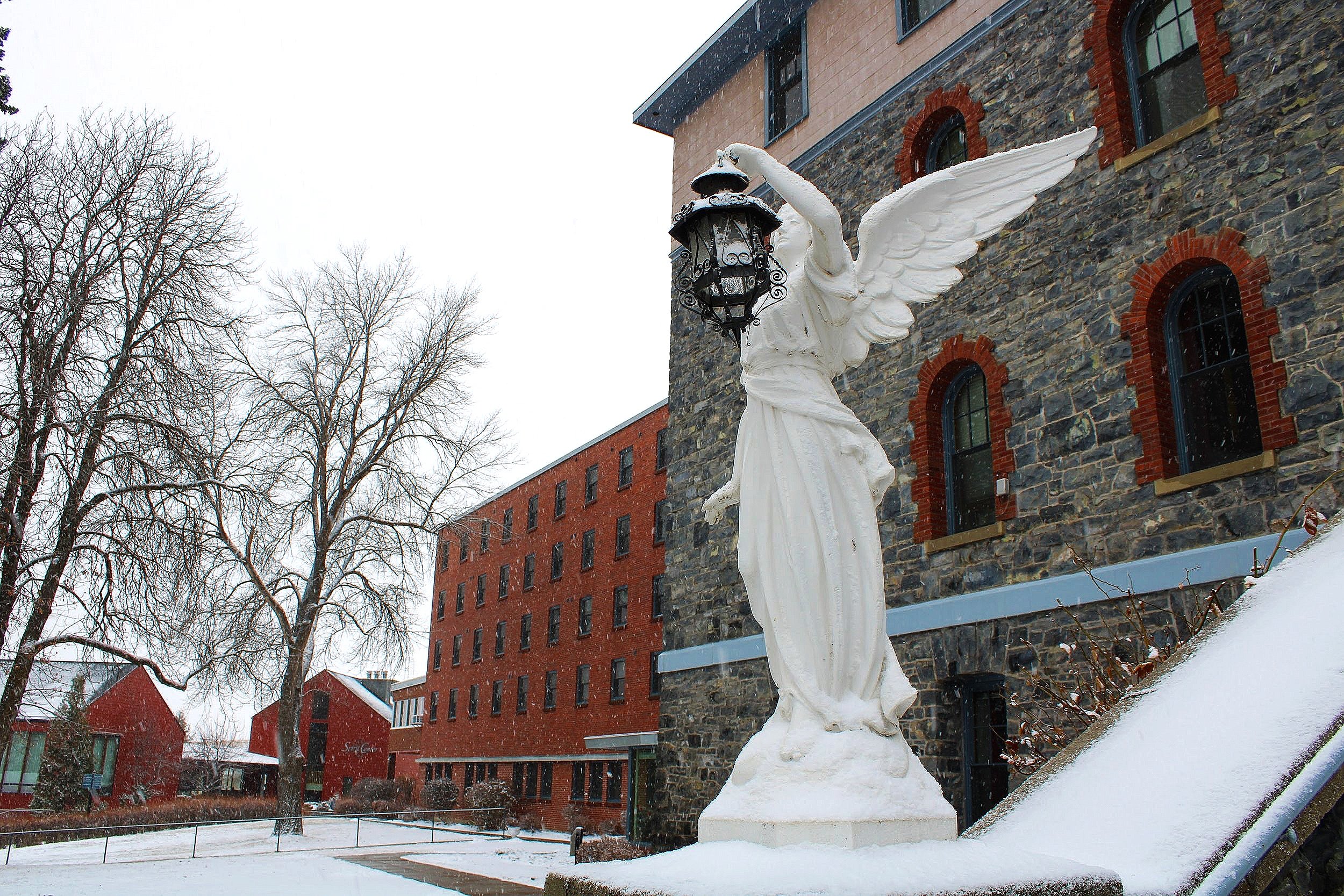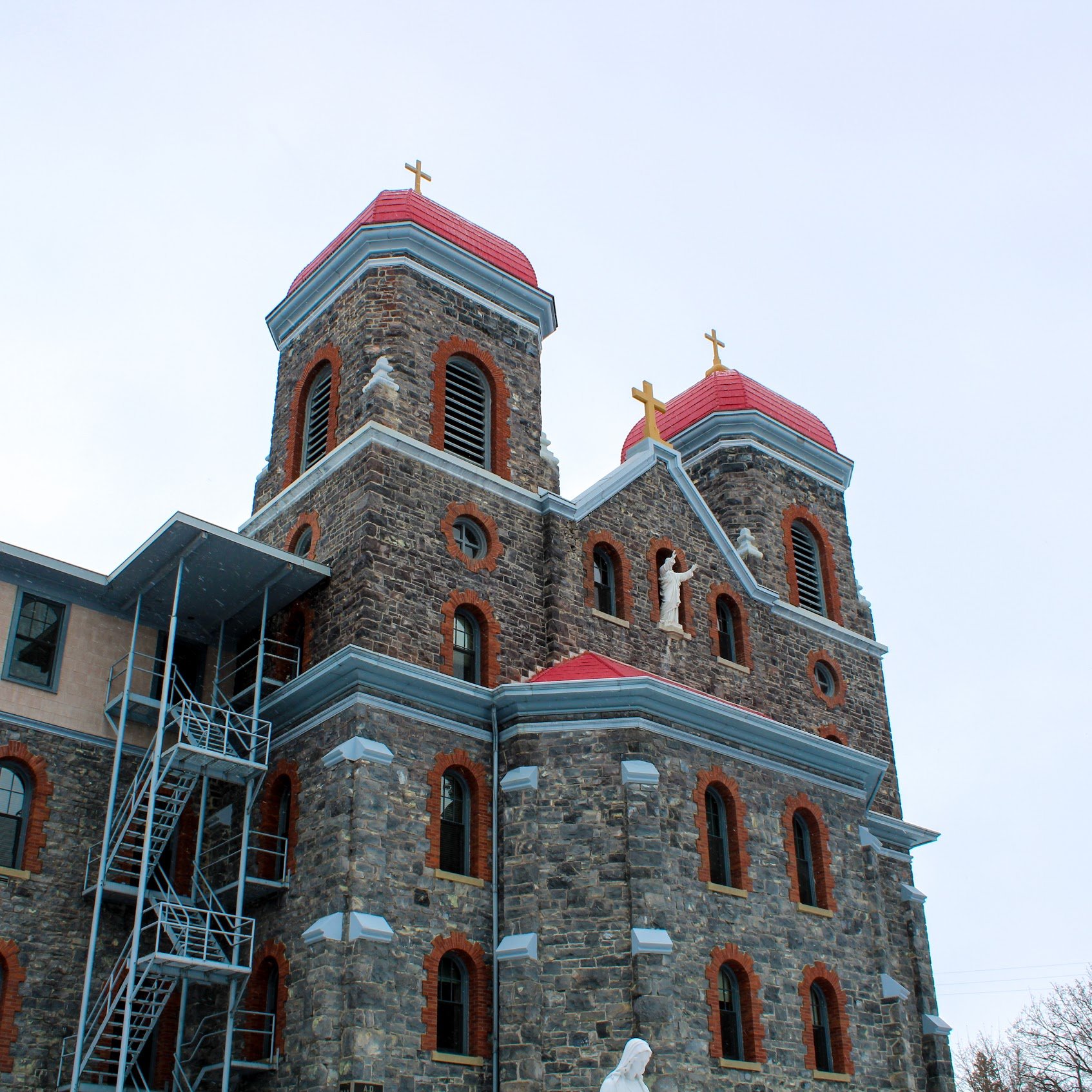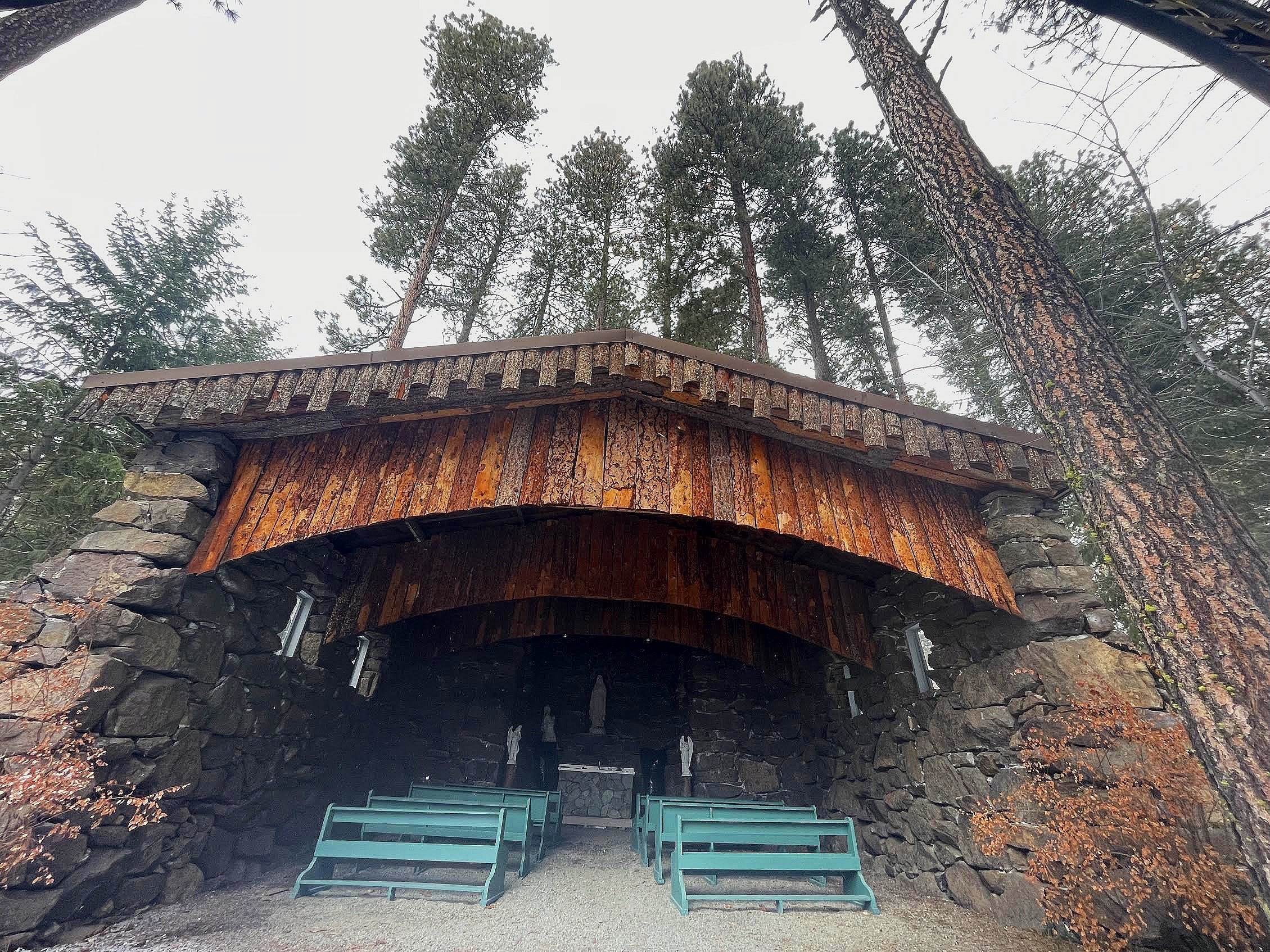Shifting Shape To Survive: St. Gertrude’s Monastery Reaches Beyond Sworn Sisters
An icon of St. Gertrude, the monastery’s namesake. Photo by Jaqueline Lopez
COTTONWOOD, Idaho — As a young mother with four spirited kids at home, Jane Somerton needed some serenity.
So at the suggestion of a sister from her parish — then in Lewiston, Idaho — she traveled 60 miles south to the Monastery of St. Gertrude, a sacred space she hadn’t before heard of.
She still remembers the details of that self-directed retreat from 1984, especially standing in the snow on the still Cottonwood prairie, just outside the porphyry stone chapel.
The cemetery covered in snow where many sisters are buried. Photo by Tracy Simmons, FāVS News.
“I could hear the sisters praying the Psalms,” she said. “And I thought ‘Oh what is this? People do this?’”
She says there were probably 130 sisters living there then.
Today, there are just 22, with an additional six working missions or living in a health care facility. The community is currently grieving the loss of its prioress, Sister Mary Forman, who died April 20 at 75 years old. But the sisters are finding support from other women outside the monastery interested in experiencing tastes and glimpses of the monastic life.
St. Getrude’s is a Benedictine monastery in rural Idaho that was founded by Swiss nuns in the United States in 1882 and moved to Cottonwood in 1907. Today the property includes the monastery, an inn, a retreat center, a gift shop and a chapel.
A visionary leader
Sister Teresa Jackson is known as the monastery’s visionary. Photo by Jaqueline Lopez.
Although fewer sisters walk the grounds now, the monastery has a visionary. Sister Teresa Jackson entered the monastery as a postulant in 1997 and took her first vows in 2000 and has long said that Benedictine life — a life of community, hospitality, justice and stewardship — isn’t just for monastics.
The St. Gertrude’s community is intensively emphasizing that message now.
“We are currently in the process of pioneering a whole new understanding of what it means to be a Benedictine community,” she said. “At a time of precipitous decline in Catholic religious communities, we are focused on becoming something new.”
They are now called the Center for Benedictine Life at the Monastery of St. Gertrude.
Jackson explained the new identity is a way to adapt for a new millennium — a day where it’s conceivable that the halls of the five-story monastery may be without any sisters at all.
“What’s happening now is we’re finding Catholic, traditional religious life is not — at least in North America — attracting people like it did,” she said. “And so I’m simply saying maybe there are new ways to understand this call, this vocation.”
According to a pamphlet explaining the change, “People acquainted with Benedictine monasteries usually think that the vowed members, sisters or monks, are the monastery while the oblates, employees, friends, donors are simply the supporters.”
Jackson said although fewer people are becoming monks and nuns, more are being drawn to the monastic, spiritual way of life.



Drawing the oblates
She describes it this way: “Benedictine life is a way of living the gospel that is profoundly spiritual, deeply practical and ultimately transformative. It is rooted in community, lived in prayer, listening and reflection and embodied through service, simplicity and care for all.
“I’m kind of provocatively saying, why do we think people have to fit into the traditional box of Roman Catholic vowed life? Let’s try some new structures, some new wineskins, if you will, from the Christian tradition,” she added.
The sisters have been working toward these new structures, slowly, for years but made official changes three years ago.
“In 2020 there was a formal passing of the baton, if you will,” Jackson explained.
The oblates began leading themselves, independently. It’s the first time a sister hasn’t directed the oblate program. An oblate is a lay person committed to living a Benedictine life.
Somerton, who now lives in Oregon, was one of the original eight people to become a St. Gertrude oblate a few years after her first visit there 39 years ago.
Today there are about 100 oblates from all over the country, though most are in Washington, Idaho and Montana. The pandemic, Somerton said, made the group stronger as they learned to stay connected digitally.
In recent years, she said, they’ve been working resolutely on finding creative ways to secure the future of St. Gertrude's.
“We’re starting to shift from being receivers of grace from the sisters and getting information, mentorship, love from the sisters to offering that to the sisters and to one another,” she said.
Somerton said lay people, volunteers, and employees are committed to St. Gertrude’s and its future.
“At the core, we’re all completely connected to those sisters and to that monastery,” she said. “It’s holy ground. Up there, it’s truly sacred. It’s healing.”
Some unavowed women are hoping to move into St. Gertrude’s in the coming years. Benedictine Cohousing Companions is a new program the monastery launched when it rolled out its new name. This is for single women who want to make an indefinite commitment to live and participate in monastic life with the sisters — without taking vows.
Traveling to St. Gertrude’s
Janine Mariscotti is on the co-housing project committee. Most years she travels twice annually from Pennsylvania to Cottonwood to visit St. Gertrude’s.
“I think there’s a real natural beauty in the area. To me, it’s a little magical there,” she said, adding that it’s like a pilgrimage to get there, taking two days of travel.
She flies from Philadelphia to Spokane, Washington, nearly three hours away, stays the night, and then takes a bus or finds a ride to the monastery.
“It’s harder for me to get to St. Gertrude’s than it is to get to Europe from Philadelphia,” she said.
But she fell in love with the place, and the community, when she first visited in 2017. The sisters’ honest hospitality, she said, is a draw that keeps her coming back. She said back in 2018 Jackson started talking to her about the co-housing community.
During the pandemic, the sisters renovated the fifth floor of their building to house the co-housing companions. Each resident would have a private room with its own bathroom and window overlooking the prairie.
Rooms have been remodeled where co-housing companions will live. Photo by Tracy Simmons, FāVS News.
Six women, all retired or close to retiring, are interested in moving to the monastery, but plans are still in the works. A concern some have voiced, Maniscotti said, is accessibility to health care providers, as Cottonwood is rural and not located near a hospital.
The draw, though, she said, is living a monastic life together and as a community, finding a balance between prayer, work and leisure.
“Essentially this is a new community in our midst,” Jackson said. “These are women who truly desire to live in Benedictine community, and for any number of reasons, they’re not going to enter as sisters.”
She said the interested women are meeting weekly on Zoom, noting that it’s a discernment process not to be taken lightly.
“It’s a substantial part of our future to have the lived continuity of a Benedictine presence in this place,” she said.
She said the new direction is two-fold.
“A big piece of it, frankly, is to keep St. Gertrude’s here,” she said. “We think it’s a sacred space, and many people have experienced it as such.”
Also, they want to become a model and provide resources for those seeking practical ways to live a Benedictine life in a new way.
A resource for others?
“Hopefully we can be a model or inspire them or give them ideas,” she said. “If we don’t, then we’re going to be like other very courageous communities that are saying, ‘We’re coming to completion. We’ve fulfilled our purpose.’ And that’s great, I so admire those monasteries, communities that are doing that. But, I think we’ve figured out, let’s give this a shot.”
Somerton agreed that the community — volunteers, employees, sisters and oblates — are committed to trying.
“We don’t know what’s beyond the horizon, but it’s coming fast, and we’re hoping and praying that we can make this work,” she said. “We’re going to take care of the sisters until the last one is gone and then shift into whatever it’s going to look like after that, with a core of people committed to the presence of the Benedictine way, Benedictine prayer, hospitality and all those things that make it such a gift to the world.”
Beginning this month and continuing through May, the monastery is leading a series on Zoom on its new Benedictine model. Jackson said more than 100 people have signed up. Information can be found on their website.
Tracy Simmons is an award-winning journalist specializing in religion reporting and digital entrepreneurship. Simmons has worked as a multimedia journalist for newspapers across New Mexico, Texas and Connecticut. Currently, she teaches journalism at Washington State University and serves as the executive director of FāVS News, a digital journalism start-up covering religion news and commentary in Spokane, Washington.




